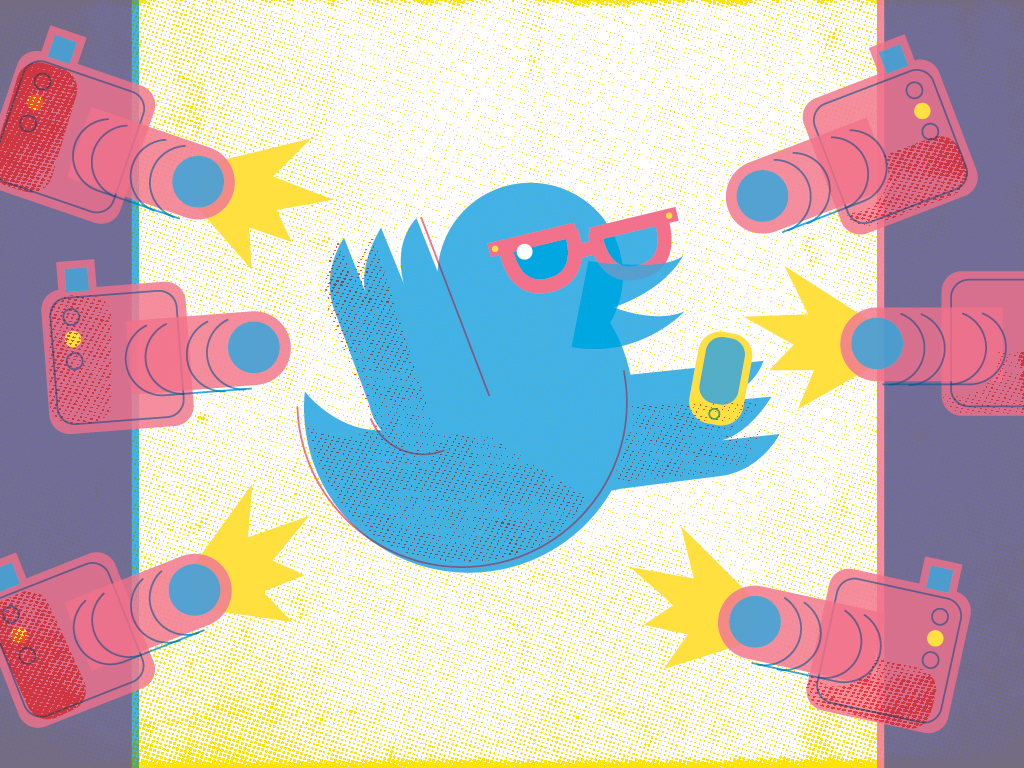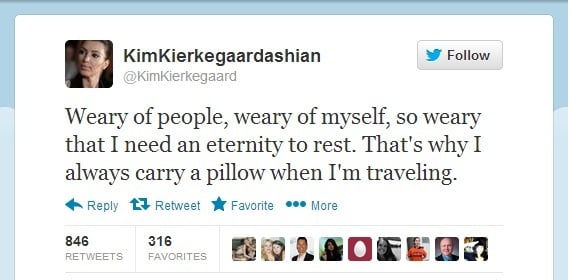How I Got 10,000 Twitter Followers In A Week
The man behind @trekandthecity reveals his identity for Junkee, and talks to Modern Day Seinfeld and Not Tilda Swinton about the strange world of Twitter celebrity.

A few weeks ago, I went viral on Twitter.
A friend and I spend most of our work days exchanging emails, links and pithy observations to crack each-other up – the stuff that makes staring at a computer screen all day just that bit more bearable. On this particular day, as we discussed the finer points of a Star Trek Voyager episode, I glanced at my DVD shelf and saw my Sex & The City box set sitting there. Then it hit me. The idea of the four sassy gal-pals from Sex & The City adrift in a world of quantum singularities and subspace emissions. Just the kind of thing that would crack my friend up. I emailed him back: “The exhaust manifolds were venting plasma, but on Deck 12, Miranda was doing some venting of her own.”
The next few hours were a flurry of emails about erotic encounters with various alien species. Just for the hell of it, I set up a Twitter account, Star Trek & The City, where I started posting Carrie Bradshaw-esque relationship platitudes replete with impenetrable sci-fi jargon. I followed a few of my friends without telling them it was me. Some of them liked what they saw, and Retweeted it. Then strangers began to do the same. When I say that it caught on overnight, I literally mean just that – I remember sitting in bed that evening in the glow of my laptop, seeing new followers and comments every time I refreshed, feeling satisfaction that I had finally given back to my beloved internet.
Within two days, The Huffington Post published a story about the account, and soon after another piece showed up on Buzzfeed. My boyfriend sat at his desk, refreshing Google every few minutes and shouting “you’ve got another one!” I was at dinner with friends when the account hit 10,000 followers, and we toasted in celebration. As my follower count grew, I became a lot more particular about the Tweets, and refused to send them out until they sounded perfect: “is this one FUNNY-funny or just amusing-funny?”. I worked hard to find the right balance of crude and pithy in-jokes about probes and Class-9 Gas Giants. The tipping point came late one night when I was chatting to a friend in the UK. I sent him the wording of one of the Tweets, asking if I’d managed to make it work. “Are you really still working on these at two in the morning?” he asked. I really was, and I knew then that it was time to stop.
I figured that if I quit while I was ahead, at least I’d have a great story. At that point, though, my curiosity had the better of me, and I needed to know what it is that makes the best parody Twitter accounts tick.
Who Makes The Twitter Parodies?
There are several types of parody Twitter accounts, and the mileage varies greatly on all of them. There are those that spring up in response to current events, delivering concentrated bursts of topical humour, which are hilarious until they suddenly aren’t anymore. Remember when the lights went out following Beyonce’s performance at the Superbowl? Within minutes, a parody account had sprung up, featuring lecherous observations in character as the lights themselves. The joke lasted roughly as long as the blackout itself and, a week or so later, a forlorn “yall forgot about me” appeared on the feed. Think of any newsworthy event, and you’ll likely find a short-lived Twitter parody that corresponds.
Some parodies are perpetual. Big Ben, not affiliated with the actual clock, lets loose a stream of ‘BONG BONG BONG’s on the hour, to the delight of nearly 400,000 followers.

The most satisfying, though, tend to be the celebrity parody accounts. There’s an ongoing wealth of material on which to draw, and if you can get the voice just right, the possibilities are endless. The fake celebrity Twitter has become an art form, and the creativity behind them is inspiring. Take Kim Kierkegaardashian, a droll mash-up that takes banal observations about fun and fashion and infuses them with heavy doses of existentialist philosophy. The joke is all in the juxtaposition, but after hundreds of Tweets, it still feels fresh.

The absolute best of these accounts are those that deliver this sort of absurdist, character-driven fare with a topical edge. For instance, if you’re not following the fake Michael Haneke, you should do so immediately. The account is a work of genius, taking the dour director and recasting him as a mean-spirited prankster, taunting fellow filmmakers like his nemesis ‘terruns malick’. The account was on fire during the recent Academy Awards, with Tweets rolling in live on such subjects as how ‘jessikuh chastayns doesnt find it funny if u pretend ur oscar is ur penis lol’.
Twitter parodies are funny stuff – we share them with our friends through the work day, and read them out to anyone within earshot, but when it comes right down to it, what the hell are they for? Who makes them and, more importantly, why? My own began and ended as a goof, a way to make my friend laugh, but there’s a lot more to them than that. If you play your cards right, you might get a book deal or launch a comedy career. I made it my mission to track down the writers behind my favourite Twitter accounts, to find out just what the hell drives them.
Meeting The Stars Of The Joke Twitterverse
There were more than a few dead ends along the way, and a few embarrassing email exchanges – the Hairpin writer Mallory Ortberg was very gracious in explaining to me that she was not actually Seinfeld2000 when I pestered her about the hilarious parody-of-a-parody-account which at one point attributed itself to her. In the end, thanks to a dogged campaign of email and Facebook stalking, I made contact with three Twitter accounts, and the seven guys behind them.
There were certain points of commonality between all the people I found. They tended to be nerdy, college-educated white guys, and most of them choose to write in pairs – that sense of bonding with a friend over a deeply-ingrained love of comedy, and a deeply-ingrained need to crack one-another up. Their reasons for Tweeting, though, proved to be many and varied. Some are stand-up comics, some are aspiring TV writers, and some have an entrepreneurial streak of the kind that makes you think of Zuckerberg and friends sitting around in their dorm room shooting the shit.
How do you know if something will go viral? Is it possible to predict? And what does it take to actually create and maintain one of these parody Twitters? I asked these questions to the guys behind Not Tilda Swinton, The Average Shark and Modern Day Seinfeld.
The Up-And Comers: Not Tilda Swinton (44579 followers)
Not Tilda Swinton may have been one the most bizarre and wonderful things every to appear on Twitter. The account took the lanky Scottish actress Tilda Swinton and imagined her as an immortal nature spirit, bathing in pools of moonlight and sheltering families of birds in her mouth. “If you will it,” she said in an early Tweet, “you, too, can be birthed, devoured, then birthed again by a starving coyote. It’s a wonderful thing.”

Comedian Eli Yudin dreamed up the idea for Not Tilda Swinton while under moderate sedation following surgery on his wisdom teeth. “I was sitting around bored and came up with a joke about Tilda Swinton being able to compress her bones and slide under doorways,” he says with a laugh. “Tilda Swinton is so weird, like a mythical creature, and after that, I realised I could do a billion more.”
Yudin wrote Not Tilda Swinton with his friend and fellow comedian Carey O’Donnell. At the time it began, they had never met in person. They were aware of each-other through Twitter – O’Donnell and another friend were behind the screamingly funny Fake Cat Fancy account – and Yudin knew that he was up to the task of writing for Tilda. The pair only met recently, when both moved to New York. “We literally forgot that we had only just met, because we’d done so much together,” O’Donnell says.

Part off the genius of Not Tilda Swinton was its brevity – the pair limited it to 200 Tweets, before sending the character into hibernation. O’Donnell tells me that they weren’t interested in overkill, and the limited number of Tweets gave them an end point and a sense of urgency. “I don’t want to name any specific accounts, but you see parody accounts start up, and months later, you see Tweets from them come up, and you just think, ‘you’re still doing that?’” Yudin says. “We didn’t want to be that way.”
I ask the pair if Not Tilda Swinton has been a big career boost, but he tells me it acts as more of a calling card. “We went from having no careers whatsoever to people knowing who we are,” he says. “Nobody’s that impressed when you say you’re a writer, but when you tell them about Not Tilda Swinton they’re like, ‘Oh, I saw that!’” The account put the pair in touch with some of their comedy heroes, including Paul F Tompkins and Patton Oswalt, who contacted them with messages of approval. As we speak, the pair are headed to LA for some TV writing meetings, so it’s safe to say we haven’t heard the last of them.

The big question, though, is whether Tilda Swinton herself has seen the account. Neither one is sure, but they laugh nervously at the prospect. “I’m worried that if she did find out about this account, she’d come back for my firstborn child,” O’Donnell says. “Then put it in a burlap sack and take it to the highlands or something.”
The College Kids: The Average Shark (120398 followers)
As Twitter parodies go, The Average Shark is simple but super effective. The account collects the thoughts of an everyday ocean predator as it swims, lurks, eats the occasional surfboard and sometimes ATTACKS. It has around 120,000 followers, but follows only one other Twitter account: Seal.

The Average Shark is actually the work of Zach Williamson, Devin Feldman and Daniel Wallace, three enterprising American college students. Zach got his start by Tweeting as Red Foreman, a spot-on parody of the grumpy That ‘70s Show patriarch. Inspired by its success, he recruited his roommate Dan, from Oregon State University, and his friend Devin, from Loyola Marymount. Between them, the three now Tweet from dozens of different accounts.
The idea for The Average Shark itself came from The Discovery Channel’s Shark Week. The trio tell me that always wanted to do an animal account, and as people are either terrified of sharks or love them, it seemed like the perfect pick. “We also wanted an account where we could do something for charity,” Williamson says, “and we’re working on a way right now to raise money for shark conservation.”

Between classes, the three spend their time bouncing around ideas for their various accounts – there are too many to list, but one of the best is Bro Tweets, a repository of tips and advice on how to be chill. “Our whole thing about when we start a Twitter account is that it has to be something we will never run out of ideas for or go stale,” Williamson says. As for The Average Shark, the aim is to keep it simple, while occasionally shaking things up with a topical Tweet or an all-out ATTACK.
“It’s a good party trick. Like, ‘Hey yo, guurl. I have over 600,000 unique Twitter followers! Wanna get me a drink and have sex over it!?’”
There’s a streak of entrepreneurialism behind all of this. I don’t press them for specifics, but Williamson assures me that Twitter is big business, and a lot of money can be made if you’re clever enough to know what you’re doing. Wallace’s plans for after graduation include a small clothing company, based on viral success. “I would like to design shirts, and different products,” he tells me. “I think having these accounts would be a good way to jump start that and get my brand out there for the world to see.”
Plus, while they don’t openly brag about their accounts, Twitter celebrity does come with certain perks. “It’s a good party trick,” Feldman says. “Like, ‘Hey yo, guurl. I have over 600,000 unique Twitter followers! Wanna get me a drink and have sex over it!?’” They haven’t quite reached Ryan Gosling-like levels of studliness yet, but they’re working on it. “So far I’m 0-2,” he says, “but I’m getting a new haircut next week, so hopefully this statistic will improve.”
The Professionals: Modern Day Seinfeld (476936 followers)
Josh Gondleman and Jack Moore are New York-based comedians. They met doing stand-up together, but were aware of each-other before that thanks to various shared connections. Like pretty much anyone who came of age in the ‘90s, they grew up loving Seinfeld, and thinking back on the show from a modern perspective proved the basis for a hugely successful Twitter account.
The idea for the Modern Day Seinfeld account was born a while ago, when a friend of Josh’s mentioned that many classic Seinfeld storylines wouldn’t work in the era of text messaging. This idea set his mind racing, and he began imagining how Jerry, Elaine and the rest of the gang would fare in the world of smartphones and DVR. “I Tweeted a few plot lines from my own account,” he says, “and Jack saw those, jumped on it, and started the Seinfeld Today account that we now co-write.”

Each of the Tweets is a plot summary for a hypothetical Seinfeld episode from the present day. They fit so well into the 140-character form that they read like little poems. The references may be updated – Jerry struggles to come to terms with texting etiquette; George concocts schemes involving Craigslist – but there is a classic Seinfeld-ian feel to the whole thing. Gondleman and Moore have a handle on the characters, their neuroses and their world, and it’s details like this that make the account really funny.

Modern Day Seinfeld is one of the heavy-hitters among Twitter parodies, nudging its way towards 500,000 followers as we speak. For Gondleman and Moore, it’s both exhilarating and terrifying to be at the reins of something so big. “There’s definitely pressure to keep the tweets going strong so we can keep attracting more followers without turning off the ones we have,” Gondleman tells me. “I think we’re both still kind of reeling from the magnitude of it. It’s easy not to feel too self-important, though, because most of the followers have no idea who I am. Being wildly un-famous is an easy way to stay grounded.”
Some final words of wisdom – while Twitter can be a great way to gain an audience, Gondleman tells me that, for the aspiring comedian, it’s no substitute for a great writing packet or a reliable background in stand-up. “Hopefully, it will show people that you’re capable,” he says, “so they’ll follow along and read your more substantial work or possibly hire you to do other writing work. It’s a fairly level platform for showcasing your sensibility and skill. It’s not the kind of thing you can build a career on, but it’s a nice addition to a portfolio that’s already strong.”
—
Alasdair Duncan is an author, freelance writer and video game-lover who has had work published in Crikey, The Drum, The Brag, Beat, Rip It Up, The Music Network, Rave Magazine, AXN Cult and Star Observer.
Illustration by Matt Roden